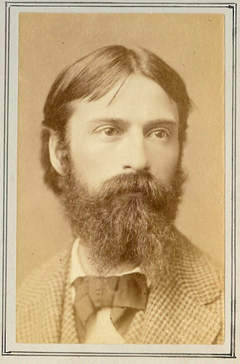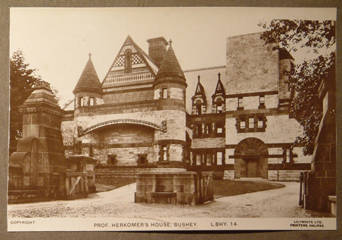 Sir Hubert von Herkomer (1849-1914) (left) is best known for his depictions of the sufferings of the poor as well as his portraits of the famous people of his day, including G.F. Watts (1897, watercolour). His social- realist illustrations of urban life which he had published in the Graphic magazine during the 1870s was new and original to a readership used to journalistic portrayals of life for the poor. His aim was to record life as it was, from the glamorous and wealthy to the down and out. His work offers insights into the Victorian world; its fears and prejudices and its hopes in the face of change.
Sir Hubert von Herkomer (1849-1914) (left) is best known for his depictions of the sufferings of the poor as well as his portraits of the famous people of his day, including G.F. Watts (1897, watercolour). His social- realist illustrations of urban life which he had published in the Graphic magazine during the 1870s was new and original to a readership used to journalistic portrayals of life for the poor. His aim was to record life as it was, from the glamorous and wealthy to the down and out. His work offers insights into the Victorian world; its fears and prejudices and its hopes in the face of change.
Hubert’s father was a woodcarver and his mother, a piano teacher. They came from Waal, near Munich in the Bavarian region of Germany, but immigrated when Hubert was young and briefly settled in the USA before moving to Southampton, England. This background of constant upheaval and impoverishment led Hubert to empathize with the people he depicted in his works.
In 1863, Herkomer began his artistic training at Southampton School of Art, where he stayed for two years before enrolling at the Munich Academy, where he was inspired by Wilheim Leibl’s (1844-1900) realist paintings. After moving back to England, Hubert spent two summer’s training at the National Art Training School (later the Royal College of Art) in South Kensington, London. Herkomer felt the academic teaching he received at each of the colleges had hindered both his imagination and choice of subject matter. Yet he was encouraged by his fellow students, such as Luke Fildes (1843-1927), who he had met in London and whose expressive paintings of the underprivileged he greatly admired. Soon Herkomer was living in Chelsea and exhibiting his works regularly.
Following his success, in 1873, the artist persuaded his parents to come and settle with him in the High Street in Bushey, Hertfordshire, fifteen miles from London. Later that year, Hubert married German-born Anna Weise, yet her ill-health put a strain on family relations and his parents moved back to Bavaria in 1877. Hubert’s father returned after the death of his wife and lived with his son until his own death in 1888. Anna and Hubert had two children, Siegfried (1874-1939) and Elsa (1877-1938) before they separated and Anna died in 1883.
Soon after, in 1884, Hubert married a Welsh nurse, Lulu Griffiths (1849-1885), who gave birth to a stillborn child and suddenly died herself three months later. This devastated Hubert and he never truly got over the pain of losing Lulu. His third wife was Lulu’s sister, Margaret Griffiths, (1857-1934) whom he married in Bavaria in 1888. They had two children, Lorenz (later ‘Lawrence’ or ‘Tutti’) (b. 1889) and Gwendydd (b. 1893).

Family life was complicated yet lively and the dramas were played out within the Arts and Crafts fairytale home, Lululaund, in Bushey (right). This extravagant, castle-like building was designed by H.H. Richardson and Herkomer meant it as a celebration of the craft traditions practised by his Bavarian ancestors.
Hubert von Herkomer had diverse and wide-ranging interests; he was a talented painter, instrumentalist, composer, author, play-wright and stage designer among other things. He was his own publicist, founded the Herkomer Art School in Bushey and became a Royal Academician in 1890. Outspoken and self-assured, he fascinated the public and he entertained many celebrities at his home, including Thomas Hardy and Ellen Terry.
In the Rob Dickins Collection at Watts there are a number of fascinating photographs of the Herkomer’s family and friends, on picnic’s, (See image 3) inspecting an aeroplane, The Watts Gallery Library offers numerous books on Victorian artists, such as Herkomer as well as Victorian subjects. For instance Hubert von Herkomer R.A.: A Study and a Biography by A.L. Baldry and Hard Times: Social realism in Victorian Art by Julian Treuherza.
References
“Picture of the Month — May 2010.” Watts Gallery. Web. 7 May 2010.
Last modified 30 May 2007